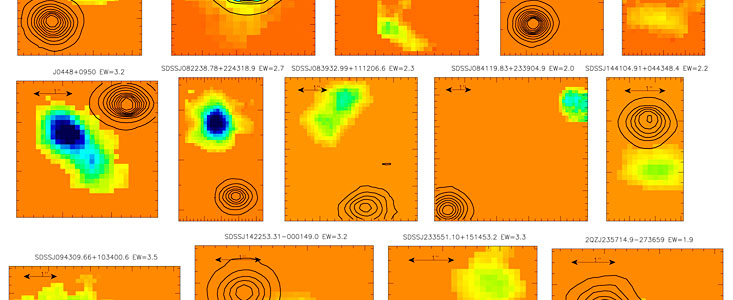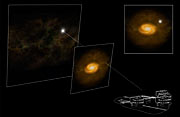Nota de Imprensa
Galaxy 'Hunting' Made Easy
Galaxies found under the Glare of Cosmic Flashlights
14 de Setembro de 2007
Astronomers using ESO's Very Large Telescope have discovered in a single pass about a dozen otherwise invisible galaxies halfway across the Universe. The discovery, based on a technique that exploits a first-class instrument, represents a major breakthrough in the field of galaxy 'hunting'.
The team of astronomers led by Nicolas Bouché have used quasars to find these galaxies. Quasars are very distant objects of extreme brilliance, which are used as cosmic beacons that reveal galaxies lying between the quasar and us. The galaxy's presence is revealed by a 'dip' in the spectrum of the quasar - caused by the absorption of light at a specific wavelength.
The team used huge catalogues of quasars, the so-called SDSS and 2QZ catalogues, to select quasars with dips. The next step was then to observe the patches of the sky around these quasars in search for the foreground galaxies from the time the Universe was about 6 billion years old, almost half of its current age.
"The difficulty in actually spotting and seeing these galaxies stems from the fact that the glare of the quasar is too strong compared to the dim light of the galaxy," says Bouché.
This is where observations taken with SINFONI on ESO's VLT made the difference. SINFONI is an infrared 'integral field spectrometer' that simultaneously delivers very sharp images and highly resolved colour information (spectra) of an object on the sky.
With this special technique, which untangles the light of the galaxy from the quasar light, the team detected 14 galaxies out of the 20 pre-selected quasar patches of sky, a hefty 70% success rate.
"This high detection rate alone is a very exciting result," says Bouché. "But, these are not just ordinary galaxies: they are most notable ones, actively forming a lot of new stars and qualifying as 'starburst galaxies'."
"We discovered that the galaxies located near the quasar sightlines are forming stars at a prodigious rate, equivalent to 20 suns per year," adds team member Celine Péroux.
These findings represent a big leap forward in the field, setting the stage for a very promising era of galaxy 'hunting'.
The astronomers now plan to use SINFONI to study in more detail each of these galaxies, by measuring their internal motions.
Notas
SINFONI is a combination of a novel infrared 'integral field spectrometer' (SPIFFI) and a special adaptive optics module (MACAO). The integral field module SPIFFI gives detailed colour, or spectral, information for each of 2000 spatial points on the sky, arranged over a contiguous two dimensional field of 32 times 64 pixels. SINFONI was developed and built by an international consortium consisting of the Max Planck Institute for Extraterrestrial Physics, Garching, Germany, ESO, and NOVA, Leiden, the Netherlands (see ESO PR 21/04).
Informações adicionais
This research is presented in a paper in press in the Astrophysical Journal ("The SINFONI Mg II Program for Line Emitters (SIMPLE): discovering starbursts near QSO sightlines" by N. Bouché et al.). The team is composed of Nicolas Bouché, Richard Davies, Frank Eisenhauer, Natascha M. Förster Schreiber, and Linda Tacconi (Max Planck Institute for Extraterrestrial Physics, Garching, Germany), Michael T. Murphy (Swinburne University of Technology, Australia), and Céline Péroux (ESO).
Contactos
Nicolas Bouché
Max Planck Institute for Extraterrestrial Physics
Garching, Germany
Tel: +49 89 30000 3830
Email: nbouche@mpe.mpg.de
Céline Péroux
ESO
Garching, Germany
Email: cperoux@eso.org
Michael T. Murphy
Centre for Astrophysics & Supercomputing
Swinburne, Australia
Tel: +61 (0)3 9214 5818
Email: mmurphy@swin.edu.au
Sobre a Nota de Imprensa
| Nº da Notícia: | eso0740 |
| Legacy ID: | PR 40/07 |
| Nome: | Galaxies, Quasar |
| Tipo: | Early Universe : Galaxy Early Universe : Galaxy : Activity : AGN : Quasar |
| Facility: | Very Large Telescope |
| Instrumentos: | SINFONI |
| Science data: | 2007ApJ...669L...5B |
Our use of Cookies
We use cookies that are essential for accessing our websites and using our services. We also use cookies to analyse, measure and improve our websites’ performance, to enable content sharing via social media and to display media content hosted on third-party platforms.
ESO Cookies Policy
The European Organisation for Astronomical Research in the Southern Hemisphere (ESO) is the pre-eminent intergovernmental science and technology organisation in astronomy. It carries out an ambitious programme focused on the design, construction and operation of powerful ground-based observing facilities for astronomy.
This Cookies Policy is intended to provide clarity by outlining the cookies used on the ESO public websites, their functions, the options you have for controlling them, and the ways you can contact us for additional details.
What are cookies?
Cookies are small pieces of data stored on your device by websites you visit. They serve various purposes, such as remembering login credentials and preferences and enhance your browsing experience.
Categories of cookies we use
Essential cookies (always active): These cookies are strictly necessary for the proper functioning of our website. Without these cookies, the website cannot operate correctly, and certain services, such as logging in or accessing secure areas, may not be available; because they are essential for the website’s operation, they cannot be disabled.
Functional Cookies: These cookies enhance your browsing experience by enabling additional features and personalization, such as remembering your preferences and settings. While not strictly necessary for the website to function, they improve usability and convenience; these cookies are only placed if you provide your consent.
Analytics cookies: These cookies collect information about how visitors interact with our website, such as which pages are visited most often and how users navigate the site. This data helps us improve website performance, optimize content, and enhance the user experience; these cookies are only placed if you provide your consent. We use the following analytics cookies.
Matomo Cookies:
This website uses Matomo (formerly Piwik), an open source software which enables the statistical analysis of website visits. Matomo uses cookies (text files) which are saved on your computer and which allow us to analyze how you use our website. The website user information generated by the cookies will only be saved on the servers of our IT Department. We use this information to analyze www.eso.org visits and to prepare reports on website activities. These data will not be disclosed to third parties.
On behalf of ESO, Matomo will use this information for the purpose of evaluating your use of the website, compiling reports on website activity and providing other services relating to website activity and internet usage.
Matomo cookies settings:
Additional Third-party cookies on ESO websites: some of our pages display content from external providers, e.g. YouTube.
Such third-party services are outside of ESO control and may, at any time, change their terms of service, use of cookies, etc.
YouTube: Some videos on the ESO website are embedded from ESO’s official YouTube channel. We have enabled YouTube’s privacy-enhanced mode, meaning that no cookies are set unless the user actively clicks on the video to play it. Additionally, in this mode, YouTube does not store any personally identifiable cookie data for embedded video playbacks. For more details, please refer to YouTube’s embedding videos information page.
Cookies can also be classified based on the following elements.
Regarding the domain, there are:
- First-party cookies, set by the website you are currently visiting. They are stored by the same domain that you are browsing and are used to enhance your experience on that site;
- Third-party cookies, set by a domain other than the one you are currently visiting.
As for their duration, cookies can be:
- Browser-session cookies, which are deleted when the user closes the browser;
- Stored cookies, which stay on the user's device for a predetermined period of time.
How to manage cookies
Cookie settings: You can modify your cookie choices for the ESO webpages at any time by clicking on the link Cookie settings at the bottom of any page.
In your browser: If you wish to delete cookies or instruct your browser to delete or block cookies by default, please visit the help pages of your browser:
Please be aware that if you delete or decline cookies, certain functionalities of our website may be not be available and your browsing experience may be affected.
You can set most browsers to prevent any cookies being placed on your device, but you may then have to manually adjust some preferences every time you visit a site/page. And some services and functionalities may not work properly at all (e.g. profile logging-in, shop check out).
Updates to the ESO Cookies Policy
The ESO Cookies Policy may be subject to future updates, which will be made available on this page.
Additional information
For any queries related to cookies, please contact: pdprATesoDOTorg.
As ESO public webpages are managed by our Department of Communication, your questions will be dealt with the support of the said Department.


